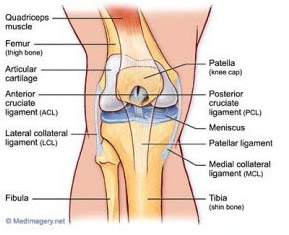Tear ACL, PCL, Meniscus (więzadła krzyżowe przednie, tylne i łękotka)
 The knee has a simple purpose. It needs to flex (bend) or extend (straighten) to allow the body to perform many activities like running, walking, kicking, and sitting. Imagine standing up from a chair if your knees couldn’t bend.
The knee has a simple purpose. It needs to flex (bend) or extend (straighten) to allow the body to perform many activities like running, walking, kicking, and sitting. Imagine standing up from a chair if your knees couldn’t bend.
While direct blows to the knee will occur, the knee is more susceptible to twisting or stretching injuries, taking the joint through a greater range of motion than it can tolerate.
If the knee is stressed from a specific direction, then the ligament trying to hold it in place against that force can tear. Ligament stretching or tears are called sprains. These sprains are graded as first, second, or third degree, based upon how much damage has occurred. Grade-one sprains stretch the ligament but don’t tear the fibers; grade-two sprains partially tear the fibers, but the ligament remains intact; and grade-three tears completely disrupt the ligament.
Twisting injuries to the knee put stress on the cartilage or meniscus and can pinch it between the tibial surface and the edges of the femoral condyle, causing tears.
Injuries of the muscles and tendons surrounding the knee are caused by acute hyperflexion or hyperextension of the knee or by overuse. These injuries are called strains. Strains are graded similarly to sprains, with first-degree strains stretching muscle or tendon fibers but not tearing them, second-degree strains partially tearing the muscle tendon unit, and third-degree strains completely tearing it.
There can be inflammation of the bursas (known as bursitis) of the knee that can occur because of direct blows or chronic use and abuse.
Acute knee injuries fall into two groups; those where there is almost immediate swelling in the joint associated with the inability to bend the knee and bear weight, and those in which there is discomfort and perhaps localized pain to one side of the knee, but with minimal swelling and minimal effects on walking.
Acute knee injuries can cause pain and swelling with difficulty bending the knee and weight-bearing. If the swelling occurs immediately, it may suggest a ligament tear or fracture. If the swelling arises over a period of many hours, meniscal or cartilage injuries may be the cause. However, injuries to the knee may involve more than one structure and the symptoms may not present classically.
Longer-term symptoms that point to knee problems will include pain and swelling in addition to other complaints. Inflammation in the joint may be caused by even minor activity. Swelling may be intermittent, brought on by activity, and may gradually resolve as the inflammation decreases.
Pain, too, may come and go and may not occur right away with activity but might be delayed as the inflammation develops. Pain can also be felt with specific activities. Pain while climbing stairs is a symptom of meniscus injury, where the cartilage is being pinched in the joint as it narrows with bending. Pain with walking down stairs suggests patellar pain, where the kneecap is being forced onto the femur.
Giving way, or a feeling of instability of the knee, or, popping or grinding in the knee is associated with cartilage or meniscus tears. “Locking” is the term used when the knee joint refuses to completely straighten, and this is almost always due to torn cartilage. In this situation, the torn piece of cartilage folds upon itself and doesn’t allow the knee to extend.